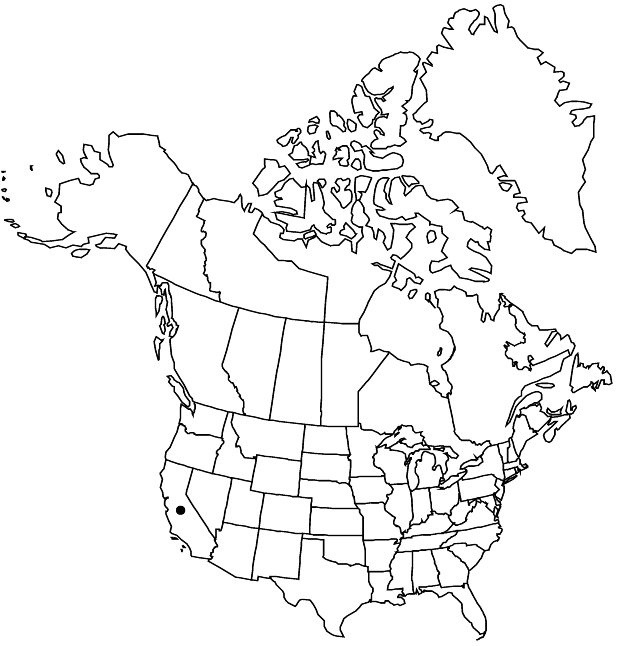Dudleya abramsii
in N. L. Britton and J. N. Rose, New N. Amer. Crassul., 14. 1903 (as abramsi) ,.
Caudices simple or apically branching and cespitose, 0.5–8 × 1–3 cm, axillary branches absent. Leaves: rosettes 1–100+, in clumps or not, 10–20 (–30) -leaved, 2–8 (–15) cm diam.; blade green, mostly linear or elliptic or oblong to oblong-lanceolate or tapering from base, 1–6 (–11) × 0.2–1.2 (–2) cm, 2–4 mm thick, base 0.5–1.5 (–2) cm wide, apex acute to subacuminate, often apiculate, surfaces not farinose, glaucous (at least when young). Inflorescences: cyme 1–4-branched, narrowly obpyramidal; branches not twisted (flowers on topside), simple or 1–3 times bifurcate; cincinni 2–3, 2–10 (–18) -flowered, scarcely circinate, 3–15 cm; floral shoots 2–25 × 0.1–0.4 (–0.6) cm; leaves 5–20, ascending, triangular-lanceolate, 4–40 × 2–11 mm, apex acute. Pedicels erect, not bent in fruit, 1–5 (–17) mm. Flowers: calyx 3–7 × 2–7 mm; petals connate 1–3 (–4.5) mm, mostly pale-yellow, straw yellow, or almost white, rarely bright-yellow, commonly red-lineolate especially on keel, 5–16 (–18) × 1.5–4.5 mm, (margins often somewhat erose), apex acute, with tips mostly erect; pistils connivent, erect. Unripe follicles erect. 2n = 34.
Distribution

Calif., nw Mexico
Discussion
Subspecies 7 (7 in the flora).
Dudleya abramsii, a widespread diploid, is largely montane, growing mostly on granite or limestone, but its northwestern subspp. bettinae, murina, and setchellii are local at lower elevations, on serpentine. It forms small clumps, 2–11 cm in diameter. From the widespread diploid D. cymosa, generally a larger plant, it is nearly distinct in its mostly cespitose, narrow-leaved rosettes and simple cyme branches, and distinctively, the antisepalous stamens are adnate higher on the corolla tube than the epipetalous and are often 1–2 mm longer. The petals commonly much exceed the stamens and pistils, and the pistils are attenuate. Both species are variable, and subsp. costatifolia is somewhat intermediate.
Five of the six subspecies are very similar, with only small differences, and only subsp. costatifolia is more distinctive.
Selected References
None.
Lower Taxa
Key
| 1 | Petals bright yellow; inflorescence branches 1-3 times bifurcate; leaf blades linear, subterete. | Dudleya abramsii subsp. costatifolia |
| 1 | Petals straw yellow or pale yellow, almost white, often red-lineolate; inflorescence branches mostly simple, or some 1-2 times bifurcate; leaf blades elliptic, oblong, oblanceolate, oblong-lanceolate, or tapering from base, terete or subterete to laminar | > 2 |
| 2 | Rosette leaf blades oblanceolate to elliptic, 1.5-4 cm; rosettes solitary | Dudleya abramsii subsp. affinis |
| 2 | Rosette leaf blades oblong, oblong-lanceolate, or tapering from base, 1-10(-11) cm; rosettes (1-)3-100+ | > 3 |
| 3 | Inflorescence branches often simple, sometimes 1-2 times bifurcate; petals red- lineolate or not. | Dudleya abramsii subsp. calcicola |
| 3 | Inflorescence branches simple; petals often red-lineolate | > 4 |
| 4 | Floral shoots 2-15 × 0.1-0.3 cm; proximalmost inflorescence leaf blades 4-15(-40) mm; petal tips often strongly outcurved; mostly on granite, 300- 1900 m. | Dudleya abramsii subsp. abramsii |
| 4 | Floral shoots 5-25 × 0.2-0.6 cm; proximalmost inflorescence leaf blades 10-30 mm; petal tips erect; serpentine, 0-600 m | > 5 |
| 5 | Rosettes 100+, leaf blades 0.3-0.7 cm wide. | Dudleya abramsii subsp. bettinae |
| 5 | Rosettes mostly 1-5, leaf blades 0.5-2 cm wide | > 6 |
| 6 | Petals straw yellow, marked with purplish red; rosette leaf blades 0.5-2 cm wide. | Dudleya abramsii subsp. murina |
| 6 | Petals pale yellow, almost white, not red-marked; rosette leaf blades 0.5-1 cm wide. | Dudleya abramsii subsp. setchellii |